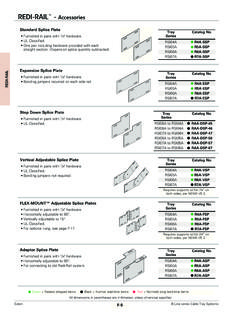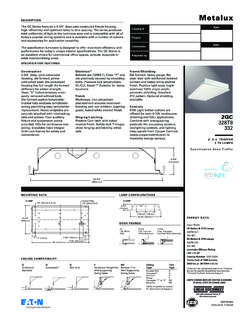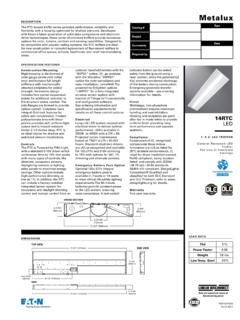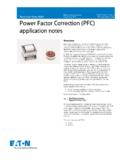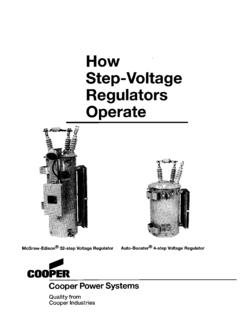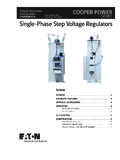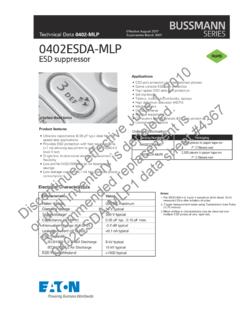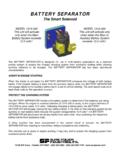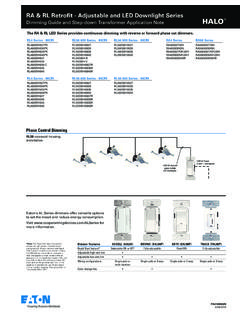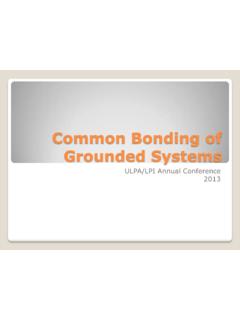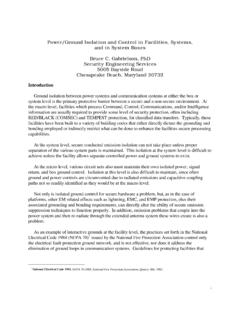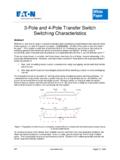Transcription of 240.85: CHANGES TO THE 2002 NEC CLARIFY REQUIREMENTS …
1 2001 Cooper Bussmann, : CHANGES TO THE 2002 NEC CLARIFY REQUIREMENTS FOR THE USE OF SLASH-RATED CIRCUIT BREAKERS AND APPLICATION OF INDIVIDUAL POLE INTERRUPTINGCAPABILITIES FOR VARIOUS GROUNDING SCHEMEST ypical plant electrical systems use three-phase distribution schemes. As an industry practice, short-circuit calculations lead to the selection of overcurrent protective devices based on available three-phasefault currents. If the overcurrent devices have an adequate three-phase interrupting rating, engineers aregenerally satisfied that the system complies with NEC often, however, do three-phase faults occur? Commonly referred to as "three-phase bolted faults",these shorts require all three legs to be electrically connected. Though bolted faults do occur, far morecommon is the mishap of a slipped screwdriver, dropped wrench, or worn insulation that shorts onephase to ground, creating a single-pole short-circuit.
2 These phase-to-ground faults affect theperformance of circuit breakers in different ways, depending upon the grounding scheme. Two of theseperformance areas were addressed by CHANGES to the 2002 NEC . They are the proper usage of slashratings and individual pole interrupting capabilities. The following paragraphs explain the reasonsbehind these 2002 Code RATINGSA slash-rated circuit breaker is one with two voltage ratings separated by a slash, such as 208Y/120 smaller of the two ratings is for overcurrents at line-to-ground voltages, meant to be cleared by onepole of the device. The larger of the two ratings is for overcurrents at line-to-line voltages, meant to becleared by two or three poles of the circuit breaker. Slash-rated circuit breakers are not intended to openphase-to-phase voltages across only one pole.
3 Where it is possible for full phase-to-phase voltage toappear across only one pole, a fully rated circuit breaker must be utilized. A fully rated circuit breaker isone that has only one voltage rating, such as a 480 volt circuit breaker. For example, a 480 volt circuitbreaker can open an overcurrent at 480 volts with only one pole, such as might occur when Phase Agoes to ground on a 480 volt B-Phase grounded of the 2002 NEC was changed to read:The change was the addition of the words solidly grounded *. This was needed to emphasize thatslash-rated devices were not appropriate on resistance-grounded and ungrounded systems. Thefollowing paragraphs explain why slash-rated devices cannot be utilized on these types of systems.* Solidly grounded is defined in of the NEC as Connection of the grounded conductor toground without inserting any resistance or impedance Applications.
4 A circuit breaker with a slash rating, such as 120/240V or 480Y/277,shall be permitted to be applied in a solidly grounded circuit where the nominal voltage of anyconductor to ground does not exceed the lower of the two values of the circuit breaker s voltagerating and the nominal voltage between any two conductors does not exceed the higher value ofthe circuit breaker s voltage Reprinted from NEC 2002 2001 Cooper Bussmann, INTERRUPTING CAPABILITIESThe single-pole interrupting capability of a circuit breaker is its ability to open an overcurrent at aspecified voltage utilizing only one pole of the circuit breaker. What are the single-pole interruptingcapabilities for overcurrent devices? Per ANSI and , an airframe/power circuit breakerhas a single-pole interrupting rating of 87% of its three-pole rating.
5 Listed three-pole molded casecircuit breakers have minimum single-pole interrupting capabilities according to Table of UL489. Table 1 of this paper indicates the single-pole ratings of various three-pole molded-case circuitbreakers taken from Table of UL 489. A similar table is shown on page 54 of the IEEE BlueBook , Recommended Practice for Applying Low-Voltage Circuit Breakers Used in Industrial andCommercial Power Systems, (Std 1015-1997). Molded-case circuit breakers may or may not be able tosafely interrupt single-pole faults above these values since they are typically not tested beyond thesevalues. For current-limiting fuses, the marked interrupting rating is the tested single-pole the ratings shown in Table 1 are too low for the application, the actual single-pole rating for thebreaker must be ascertained to insure proper an example of single-pole interrupting capability in a typical installation, consider a common three-pole, 20 amp, 480 volt circuit breaker with a three-pole interrupting rating of 65,000 amperes.
6 Referringto Table 1, this breaker has an 8,660 ampere single-pole interrupting capability for 480 volt faults acrossone pole. If the available line-to-ground fault current exceeds 8,660 amps at 480 volts, such as mightoccur on the secondary of a 1000 KVA, 480 volt, corner-grounded delta transformer, the circuit breakermay be misapplied. In this case, the breaker manufacturer must be consulted to verify interruptingratings and proper Fine Print Note was added to of the 2002 NEC to alert users that circuit breakers have single-pole interrupting capabilities that must be considered for proper following paragraphs will also explain why this FPN was added to the 2002 NEC .CALCULATING GROUND FAULT CURRENTSHow much short-circuit current will flow in a ground fault condition? The answer is dependent uponthe location of the fault with respect to the transformer secondary.
7 Referring to Figure 2, the groundfault current flows through one coil of the wye transformer secondary and through the phase FPN: Proper application of molded case circuit breakers on 3-phase systems, otherthan solidly grounded wye, particularly on corner grounded delta systems, considers thecircuit breakers individual pole interrupting from NEC 2002 2001 Cooper Bussmann, the point of the fault. The return path is through the enclosure and conduit to the bonding jumper andback to the secondary through the grounded neutral. Unlike three-phase faults, the impedance of thereturn path must be used in determining the magnitude of ground fault current. This ground returnimpedance is usually difficult to calculate. If the ground return path is relatively short ( close to thecenter tap of the transformer), the ground fault current will approach the three-phase 1 Single-Pole Interrupting Ratings for Three-Pole Molded CaseCircuit Breakers (ANY )
8 FRAME RATING240V480/277V480V600/347V600V100A Maximum250V Maximum4,330--------100A Maximum251-600V--10,0008,66010,0008,6601 01 8008,66010,0008,66010,0008,660801 120012,12014,00012,12014,00012,1201201 200014,00014,00014,00014,00014,0002001 250020,00020,00020,00020,00020,0002501 300025,00025,00025,00025,00025,0003001 400030,00030,00030,00030,00030,0004001 500040,00040,00040,00040,00040,0005001 600050,00050,00050,00050,00050,000 Theoretically, a bolted line-to-ground fault may be higher than a three-phase bolted fault since the zero-sequence impedance can be less than the positive sequence impedance. The ground fault location willdetermine the level of short-circuit current available. The prudent design engineer assumes that theground fault current equals at least the available three-phase bolted fault current and makes sure that theovercurrent devices are rated GROUNDED WYE SYSTEMSThe Solidly Grounded Wye system shown in Figure 1 is by far the most common type of electricalsystem.
9 This system is typically delta connected on the primary and has an intentional solid connectionbetween the ground and the center of the wye connected secondary (neutral). The grounded neutralconductor carries single-phase or unbalanced three-phase current. This system lends itself well toindustrial applications where 480V(L-L-L) three-phase motor loads and 277V(L-N) lighting is required. Figure 1 - Solidly Grounded WYE System 2001 Cooper Bussmann, a fault occurs between any phase conductor and ground (Figure 2), the available short-circuit currentis limited only by the combined impedance of the transformer winding, the phase conductor and theequipment ground path from the point of the fault back to the source. Some current (typically 5%) willflow in the parallel earth ground path.
10 Since the earth impedance is typically much greater than theequipment ground path, current flow through earth ground is generally 2 - Single-Pole Fault to Ground Solidly Grounded Wye SystemIn solidly grounded wye systems, the first low impedance fault to ground is generally sufficient toopen the overcurrent device on the faulted leg. In Figure 2, this fault current causes the branch circuitovercurrent device to clear the 277 volt fault. Because the branch circuit device will clear the faultwith only 277 volts across one pole, a slash-rated 480Y/277 volt circuit breaker is perfectly system requires compliance with single-pole interrupting capability for 277 volt faults on onepole. If the overcurrent devices have a single-pole interrupting capability adequate for the availableshort-circuit current, then the system meets NEC not as common as the solidly grounded wye connection, the following three systems aretypically found in industrial installations where continuous operation is essential.
